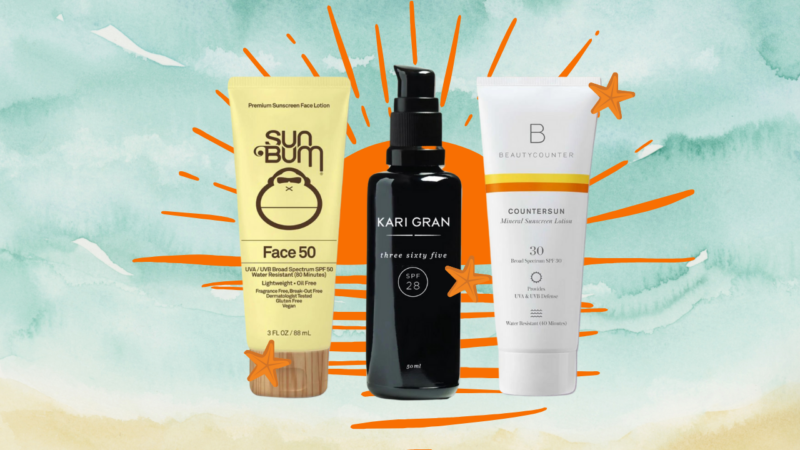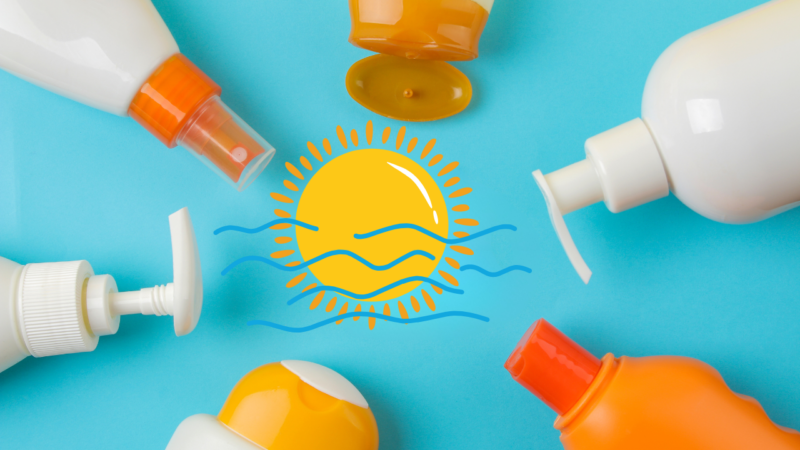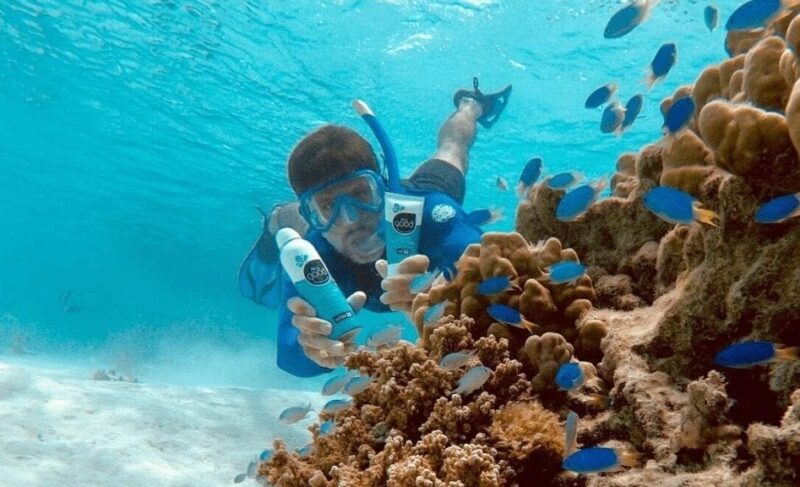Protecting marine life and coral reefs is crucial for maintaining biodiversity and healthy ecosystems.
Traditional sunscreens have been shown to cause significant harm to marine environments, particularly coral reefs.
Reef-safe sunscreens offer a promising solution by providing sun protection without the negative environmental impact.
What Makes a Sunscreen Reef-Safe?

Reef-safe sunscreens are specifically formulated to minimize their impact on marine ecosystems. Here are the key criteria and components that define reef-safe sunscreens:
Non-Nano Zinc Oxide
Non-nano zinc Oxide is a mineral-based ingredient that provides broad-spectrum UV protection by sitting on the skin’s surface and reflecting UVA and UVB rays.
Because it does not dissolve in water, it poses minimal risk to marine life.
The non-nano formulation ensures that the particles are large enough not to be ingested by coral and other marine organisms.
Titanium Dioxide
Like zinc oxide, titanium dioxide is a mineral used in sunscreens to provide UV protection.
When used in non-nano form, it remains on the skin’s surface, reducing the likelihood of harming marine ecosystems.
Both these ingredients effectively protect the skin without the detrimental effects of chemical sunscreens.
Avoidance of Harmful Chemicals
Reef-safe sunscreens intentionally exclude certain chemicals known to cause damage to marine environments.
Chemicals such as oxybenzone, octinoxate, and octocrylene are linked to coral bleaching, where corals lose their vibrant colors and vital symbiotic algae.
These chemicals can also disrupt the development and reproductive systems of marine life.
Certifications and Reliable Labels

Protect Land and Sea certification indicates that sunscreen has been thoroughly tested and verified to be free of ingredients harmful to marine life.
Products with this certification adhere to strict environmental safety standards, providing consumers with confidence that their sunscreen choice is truly reef-safe.
Another important certification, EcoCert is awarded to products that are environmentally friendly and made with sustainable practices.
Sunscreens with this label meet high standards of organic and ecological responsibility.
The Benefits of Reef-Safe Sunscreens

Reef-safe sunscreens offer several significant benefits for both the environment and human health.
These benefits highlight the importance of making eco-conscious choices in our daily lives, particularly when it comes to sun protection.
Protection of Coral Reefs
Traditional sunscreens contain chemicals such as oxybenzone and octinoxate, which can cause coral bleaching, inhibit growth, and disrupt reproductive cycles.
These chemicals can linger in the water long after application, causing lasting damage to coral reefs.
Reef-safe sunscreens, on the other hand, use non-nano minerals like zinc oxide and titanium dioxide that do not dissolve in water, thus not harming coral reefs.
It helps in maintaining the vibrant colors and health of coral reefs, which are vital ecosystems for marine life.
Preservation of Marine Biodiversity
By avoiding harmful chemicals, reef-safe sunscreens help protect various marine species, including fish, sea turtles, and other organisms that depend on coral reefs for survival.
Healthy coral reefs support a diverse range of marine life by providing:
- Habitat
- Food
- Breeding grounds
Using reef-safe sunscreens contributes to the overall health of these ecosystems, ensuring that marine biodiversity is preserved for future generations.
Minimization of Water Pollution
Traditional sunscreens contribute to water pollution, affecting not only coral reefs but also other parts of the marine ecosystem.
The chemicals can accumulate in the water, influencing the water quality and posing risks to aquatic life.
Reef-safe sunscreens minimize this form of pollution, helping to maintain cleaner and healthier ocean waters.
Safe for Human Skin
Mineral-based sunscreens are less likely to cause skin irritations or allergic reactions compared to chemical sunscreens.
They form a physical barrier on the skin that reflects UV rays, making them suitable for sensitive skin and providing effective protection against both UVA and UVB radiation.
Reduced Chemical Exposure
By using reef-safe sunscreens, individuals reduce their exposure to potentially harmful chemicals found in traditional sunscreens.
Chemicals like oxybenzone can penetrate the skin and enter the bloodstream, where they may cause hormonal disruptions and other health issues.
Reef-safe sunscreens eliminate these risks by using natural, non-toxic ingredients.
Gentle on the Skin
The natural ingredients in reef-safe sunscreens, such as non-nano zinc oxide and titanium dioxide, are gentle on the skin and can provide added benefits like soothing and anti-inflammatory properties.
Effective for All Ages
Reef-safe sunscreens are safe for use on children and babies, whose skin is more delicate and sensitive.
Parents can feel confident in using these sunscreens to protect their young ones without worrying about harmful chemical exposure.
Broad-Spectrum Protection
Many reef-safe sunscreens offer broad-spectrum protection, meaning they protect against both UVA and UVB rays.
UVA rays can prematurely age the skin, causing wrinkles and age spots, while UVB rays can burn the skin.
Both types of UV rays contribute to the risk of skin cancer. By choosing a reef-safe sunscreen, individuals can ensure comprehensive sun protection.
Eco-Friendly Packaging
Some reef-safe sunscreen brands also prioritize eco-friendly packaging, using recyclable, biodegradable, or reusable materials.
It reduces plastic waste and its impact on the environment, aligning with broader sustainability goals.
How to Choose Reef-Safe Sunscreens
Selecting the right reef-safe sunscreen involves paying attention to ingredients, certifications, and brands.
Here are some tips to help you make an informed choice:
| Category | Criteria | Details |
|---|---|---|
| Look for Mineral-Based Sunscreens | Non-Nano Zinc Oxide/Titanium Dioxide | Physical blockers of UV radiation; stable in water, minimal marine impact. |
| Avoid Chemical UV Filters | Avoid oxybenzone, octinoxate, octocrylene; linked to coral bleaching and hormone disruption. | |
| Check for Certifications | Protect Land and Sea Certification | Ensures no harmful ingredients for coral reefs and marine life. |
| Other Certifications | EcoCert: Organic and environmentally friendly.
NSF Organic: High environmental standards. |
|
| Read Labels Carefully | Be Wary of Vague Claims | Verify “reef-friendly” claims with certifications or ingredients list. |
| Check Ingredients List | Look for non-nano zinc oxide/titanium dioxide; avoid oxybenzone, octinoxate, similar filters. | |
| Recommended Brands and Products | Badger Balm | Natural, biodegradable, reef-safe; various SPF levels. |
| All Good | Reef-safe, eco-friendly packaging, suitable for sensitive skin. | |
| ThinkSport | Non-toxic, biodegradable, broad-spectrum protection. |
The Bottom Line
Reef-safe sunscreens play a vital role in protecting marine life and coral reefs from the harmful effects of traditional sunscreens.
Every individual action counts, and collectively, we can make a significant impact on preserving the health and biodiversity of our oceans.
Choose reef-safe sunscreens and be part of the solution to protect our precious marine ecosystems.




